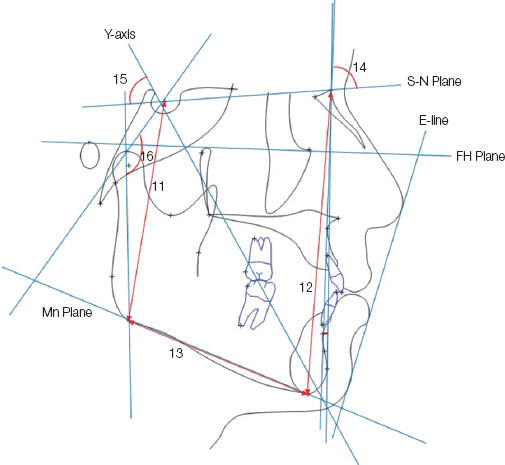J Dent Rehabil Appl Sci.
2018 Mar;34(1):10-16. 10.14368/jdras.2018.34.1.10.
Analysis of effects from usage of skeletal anchorage-assisted Pendulum appliance on vertical component of craniofacial structure
- Affiliations
-
- 1Department of Orthodontics, College of Dentistry, Dankook University, Cheonan, Republic of Korea. jwlee@dankook.ac.kr
- KMID: 2439251
- DOI: http://doi.org/10.14368/jdras.2018.34.1.10
Abstract
- PURPOSE
The purpose of this study was to evaluate distalizing effects from the Pendulum appliance on vertical component of craniofacial structures.
MATERIALS AND METHODS
20 Patients who visited for orthodontic treatments are assigned to two groups. Group I, SN-MP > 37 degrees are showing hyperdivergent pattern. Group II, 29 < SN-MP < 37 degrees are showing mesocephalic pattern. Each group are consisted of 10 people.
RESULTS
AND CONCLUSIONS: Differences between skeletal classifications result in significant differences at labioversion of lower incisors and distalized amount, which is larger at Group I (P <.05). Group II has only shown significant distalized molars (P < .05). Labioversion of lower incisors has not shown significant change. Skeletal anchorage-assisted Pendulum appliance doesn't deteriorate vertical component nor significantly improve.
Keyword
MeSH Terms
Figure
Reference
-
References
1. Bolla E, Muratore F, Carano A, Bowman SJ. Evaluation of maxillary molar distalization with the distal jet: a comparison with other contemporary methods. Angle Orthod. 2002; 72:481–94. PMID: 12401059.2. Burhan AS. Combined treatment with headgear and the Frog appliance for maxillary molar distalization: a randomized controlled trial. Korean J Orthod. 2013; 43:101–9. DOI: 10.4041/kjod.2013.43.2.101. PMID: 23671835. PMCID: PMC3650212.3. Fuziy A, Rodrigues de Almeida R, Janson G, Angelieri F, Pinzan A. Sagittal, vertical, and transverse changes consequent to maxillary molar distalization with the pendulum appliance. Am J Orthod Dentofacial Orthop. 2006; 130:502–10. DOI: 10.1016/j.ajodo.2004.12.031. PMID: 17045150.4. Patel MP, Janson G, Henriques JF, de Almeida RR, de Freitas MR, Pinzan A, de Freitas KM. Comparative distalization effects of Jones jig and pendulum appliances. Am J Orthod Dentofacial Orthop. 2009; 135:336–42. DOI: 10.1016/j.ajodo.2007.01.035. PMID: 19268832.5. Mah SJ, Kim JE, Ahn EJ, Nam JH, Kim JY, Kang YG. Analysis of midpalatal miniscrew-assisted maxillary molar distalization patterns with simultaneous use of fixed appliances: a preliminary study. Korean J Orthod. 2016; 46:55–61. DOI: 10.4041/kjod.2016.46.1.55. PMID: 26877983. PMCID: PMC4751302.6. Escobar SA, Tellez PA, Moncada CA, Villegas CA, Latorre CM, Oberti G. Distalization of maxillary molars with the bone-supported pendulum: a clinical study. Am J Orthod Dentofacial Orthop. 2007; 131:545–9. DOI: 10.1016/j.ajodo.2006.08.012. PMID: 17418723.7. Onçağ G, Seçkin O, Dinçer B, Arikan F. Osseointegrated implants with pendulum springs for maxillary molar distalization: a cephalometric study. Am J Orthod Dentofacial Orthop. 2007; 131:16–26. DOI: 10.1016/j.ajodo.2005.07.015. PMID: 17208102.8. Onçağ G, Akyalçin S, Arikan F. The effectiveness of a single osteointegrated implant combined with pendulum springs for molar distalization. Am J Orthod Dentofacial Orthop. 2007; 131:277–84.9. Polat-Ozsoy O, Kircelli BH, Arman-Ozçirpici A, Pektaş ZO, Uçkan S. Pendulum appliances with 2 anchorage designs: conventional anchorage vs bone anchorage. Am J Orthod Dentofacial Orthop. 2008; 133:339. DOI: 10.1016/j.ajodo.2007.10.002. PMID: 18331928.10. Fudalej P, Antoszewska J. Are orthodontic distalizers reinforced with the temporary skeletal anchorage devices effective? Am J Orthod Dentofacial Orthop. 2011; 139:722–9. DOI: 10.1016/j.ajodo.2011.01.019. PMID: 21640877.11. Grec RH, Janson G, Branco NC, Moura-Grec PG, Patel MP, Castanha Henriques JF. Intraoral distalizer effects with conventional and skeletal anchorage: a meta-analysis. Am J Orthod Dentofacial Orthop. 2013; 143:602–15. DOI: 10.1016/j.ajodo.2012.11.024. PMID: 23631962.12. Keles A, Erverdi N, Sezen S. Bodily distalization of molars with absolute anchorage. Angle Orthod. 2003; 73:471–82. PMID: 12940570.13. Kinzinger GS, Wehrbein H, Diedrich PR. Molar distalization with a modified pendulum appliancein vitro analysis of the force systems and in vivo study in children and adolescents. Angle Orthod. 2005; 75:558–67. PMID: 16097224.14. Caprioglio A, Fontana M, Longoni E, Cozzani M. Long-term evaluation of the molar movements following Pendulum and fixed appliances. Angle Orthod. 2013; 83:447–54. DOI: 10.2319/050812-378.1. PMID: 23075060.15. Sar C, Kaya B, Ozsoy O, Özcirpici AA. Comparison of two implant-supported molar distalization systems. Angle Orthod. 2013; 83:460–7. DOI: 10.2319/080512-630.1. PMID: 23106546.16. Kang JM, Park JH, Bayome M, Oh M, Park CO, Kook YA, Mo SS. A three-dimensional finite element analysis of molar distalization with a palatal plate, pendulum, and headgear according to molar eruption stage. Korean J Orthod. 2016; 46:290–300. DOI: 10.4041/kjod.2016.46.5.290. PMID: 27668192. PMCID: PMC5033768.17. Kärcher H, Byloff FK, Clar E. The Graz implant supported pendulum, a technical note. J Craniomaxillofac Surg. 2002; 30:87–90. DOI: 10.1054/jcms.2002.0281. PMID: 12069510.18. Yu IJ, Kook YA, Sung SJ, Lee KJ, Chun YS, Mo SS. Comparison of tooth displacement between buccal mini-implants and palatal plate anchorage for molar distalization: a finite element study. Eur J Orthod. 2014; 36:394–402. DOI: 10.1093/ejo/cjr130. PMID: 22051536.19. Hilgers JJ. The pendulum appliances for Class II non-compliance therapy. J Clin Orthod. 1992; 26:706–14. PMID: 1298751.20. Hilgers JJ, Bennet RK. The pendulum appliance: creating the gain. Clin Impressions. 1994; 3:14–23.21. Triaca A, Antonini M, Wintermantel E. Ein neus titan-flachschrauben-implantat zur orthodontischen verankerung am anterioren gaumen. Inf Orthod Kieferorthop. 1992; 24:251–7.22. Wehrbein H, Merz BR, Diedrich P. Palatal bone support for orthodontic implant anchorage-a clinical and radiological study. Eur J Orthod. 1999; 21:6570. DOI: 10.1093/ejo/21.1.65.23. Kircelli BH, Pektaş ZO, Kircelli C. Maxillary molar distalization with a bone-anchored pendulum appliance. Angle Orthod. 2006; 76:650–9. PMID: 16808573.24. Byloff FK, Darendeliler MA. Distal molar movement using the pendulum appliance. Part 1: Clinical and radiological evaluation. Angle Orthod. 1997; 67:249–60. PMID: 9267573.
- Full Text Links
- Actions
-
Cited
- CITED
-
- Close
- Share
- Similar articles
-
- Three dimensional analysis of tooth movement using different types of maxillary molar distalization appliances
- Comparative evaluation of molar distalization therapy using pendulum and distal screw appliances
- Analysis of midpalatal miniscrew-assisted maxillary molar distalization patterns with simultaneous use of fixed appliances: A preliminary study
- The frog appliance for upper molar distalization: a case report
- Directional forces using skeletal anchorage for treatment of skeletal Class II div.1 malocclusion






